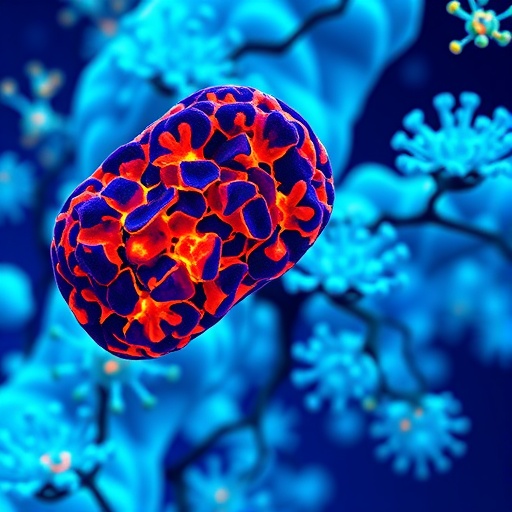In a groundbreaking study set to redefine our understanding of liver fibrosis, researchers have uncovered a novel molecular pathway operating in hepatocytes, the chief cells of the liver, which plays a crucial role in the progression of metabolic dysfunction-associated steatohepatitis (MASH). This discovery pivots on the non-apoptotic functions of caspase-8, an enzyme traditionally recognized for orchestrating programmed cell death, and its newly identified interaction with a protein termed meteorin. The implications of this finding reach deep into the mechanisms of liver disease, potentially unveiling new targets for therapeutic intervention in what is rapidly becoming a global health crisis.
Fibrosis in the context of MASH represents the excessive accumulation of extracellular matrix proteins that progressively disrupt the liver architecture and function. While prior research has extensively documented inflammatory pathways and metabolic imbalances that precipitate MASH, the molecular underpinnings connecting hepatocyte stress responses and fibrotic remodeling have remained elusive. The study spearheaded by Wang et al. delves into this grey area, illuminating how caspase-8, beyond its canonical role in apoptosis, triggers a cascade that engages meteorin, culminating in fibrosis enhancement.
What makes this pathway particularly intriguing is its departure from apoptosis, the process traditionally linked to caspase-8 activation. Instead of leading hepatocytes towards programmed death, caspase-8 here assumes a signaling role that fosters fibrotic activity. This non-apoptotic function challenges existing paradigms and suggests that caspase-8’s regulatory repertoire is far more versatile than previously appreciated. By revealing this dual functionality, the study opens avenues to rethink how cell survival and death pathways intertwine with chronic disease progression.
Central to this novel pathway is meteorin, a protein formerly uncharacterized in hepatic fibrogenesis. The researchers elucidate that upon activation by caspase-8, meteorin propagates signals within hepatocytes that incite pro-fibrotic gene expression. This inner signaling loop effectively transforms hepatocytes from passive substrates subjected to injury into active participants remodeling their local extracellular environment. Such a discovery signifies a paradigm shift in how we define hepatocyte involvement in liver pathology, elevating these cells from bystanders to key drivers of fibrosis.
The investigative team employed a combination of cutting-edge molecular biology techniques, including CRISPR-Cas9 mediated gene editing, proteomics, and transcriptomics, to delineate this pathway. Mouse models of diet-induced MASH were instrumental in demonstrating that disruption of either caspase-8 or meteorin activity markedly attenuated fibrosis without inducing hepatocyte apoptosis. This clearly decouples fibrosis from cell death in this context, a finding that could reshape therapeutic strategies to mitigate liver injury while preserving cell viability.
One of the remarkable aspects of this study is its insight into the spatial and temporal dynamics of the caspase-8–meteorin axis. The data indicate that activation occurs early during metabolic stress, preceding overt fibrosis, suggesting that this pathway might serve as an initial molecular switch for disease progression. This temporal window offers a strategic target for early intervention, potentially halting or reversing fibrotic development before irreversible liver damage ensues.
Mechanistically, caspase-8 appears to interact with specific intracellular signaling mediators upon metabolic perturbation, leading to post-translational modifications of meteorin that stabilize it and enhance its pro-fibrotic signaling capabilities. Such biochemical fine-tuning indicates a sophisticated regulatory network within hepatocytes, balancing cellular stress responses with tissue remodeling demands. Decoding these molecular adjustments further illuminates the complexity of non-apoptotic caspase-8 functions and their pathological significance.
The findings also reconcile some contradictory observations in liver fibrosis research, where caspase-8 inhibition did not yield anticipated therapeutic benefits, possibly due to the unappreciated non-apoptotic roles highlighted here. This dualistic function suggests that therapeutics aimed indiscriminately at caspase-8 could inadvertently interfere with its non-fibrogenic activities, underscoring the necessity for refined molecules that modulate its specific interactions with meteorin.
From a clinical perspective, the caspase-8–meteorin pathway could serve as a biomarker axis for early detection of fibrosis risk in patients with metabolic liver disease. Noninvasive assays targeting surrogates of meteorin activation or its downstream effectors could revolutionize screening protocols, identifying high-risk individuals before irreversible histopathological changes ensue. This holds substantial promise for personalized medicine approaches in hepatology.
Moreover, the study’s insights extend beyond liver disease, hinting at similar non-apoptotic caspase-8 functions in other tissues subjected to metabolic stress. Such conserved signaling mechanisms might influence fibrosis in organs like the kidneys, lungs, and heart, broadening the impact of these findings across diverse fibrotic diseases. Future research may probe the universality of the caspase-8–meteorin pathway, potentially unifying disparate fibrotic pathologies under a common molecular framework.
The investigation also raises fascinating questions about the evolutionary biology of caspase-8, traditionally assigned the role of executor in cell death pathways. Its repurposing as a modulator of fibrogenesis illustrates molecular adaptability, possibly reflecting evolutionary pressures to fine-tune tissue repair and remodeling in response to injury. Understanding these evolutionary nuances could provide deeper insights into the balance between regeneration and fibrosis.
Importantly, therapeutic targeting of the caspase-8–meteorin pathway must consider potential off-target effects, given caspase-8’s involvement in immune responses and other cell regulatory functions. Precision delivery systems or tissue-specific modulators might be required to exploit this pathway safely. Drug development focusing on the interface between caspase-8 and meteorin provides a promising yet challenging frontier.
This discovery also necessitates revisiting the diagnostic criteria and staging of MASH fibrosis. Molecular profiling incorporating caspase-8 and meteorin expression patterns could augment histological assessments, offering a more nuanced understanding of disease activity and progression kinetics. Such integration of molecular and morphological data enhances the precision of liver disease classification.
The profound impact of metabolic stress on hepatocytes, as revealed by the caspase-8–meteorin axis, underscores the importance of lifestyle factors in modulating disease trajectory. With obesity and type 2 diabetes on the rise, molecular insights like these spotlight the urgent need for preventative strategies complementing pharmacologic advances. Targeted therapies could, in future, be combined with metabolic modulation to comprehensively address MASH fibrosis.
Overall, this seminal study by Wang et al. signifies a transformative leap in hepatology, unveiling a complex and unexpected molecular interplay that underpins fibrotic progression in metabolic liver disease. The caspase-8–meteorin pathway offers a fertile ground for therapeutic innovation, promising to shift paradigms in the management of MASH and potentially other fibrotic disorders. As the scientific community continues to unravel this pathway’s intricacies, hope mounts for novel interventions capable of mitigating a condition that currently exacts a formidable burden on global health.
Subject of Research: Molecular mechanisms driving fibrosis in metabolic dysfunction-associated steatohepatitis (MASH), focusing on the non-apoptotic functions of caspase-8 and the role of meteorin in hepatocytes.
Article Title: A non-apoptotic caspase-8–meteorin pathway in hepatocytes promotes MASH fibrosis.
Article References:
Wang, X., Moore, M.P., Shi, H. et al. A non-apoptotic caspase-8–meteorin pathway in hepatocytes promotes MASH fibrosis. Nat Metab (2025). https://doi.org/10.1038/s42255-025-01355-1
Image Credits: AI Generated
Tags: caspase-8 and meteorin interactionchronic liver disease researchextracellular matrix accumulationfibrotic remodeling pathwaysglobal health crisis of liver fibrosishepatocyte stress responsesliver architecture disruptionliver fibrosis mechanismsmetabolic dysfunction-associated steatohepatitisnon-apoptotic caspase-8 functionsnovel molecular pathways in hepatologytherapeutic targets for liver disease





